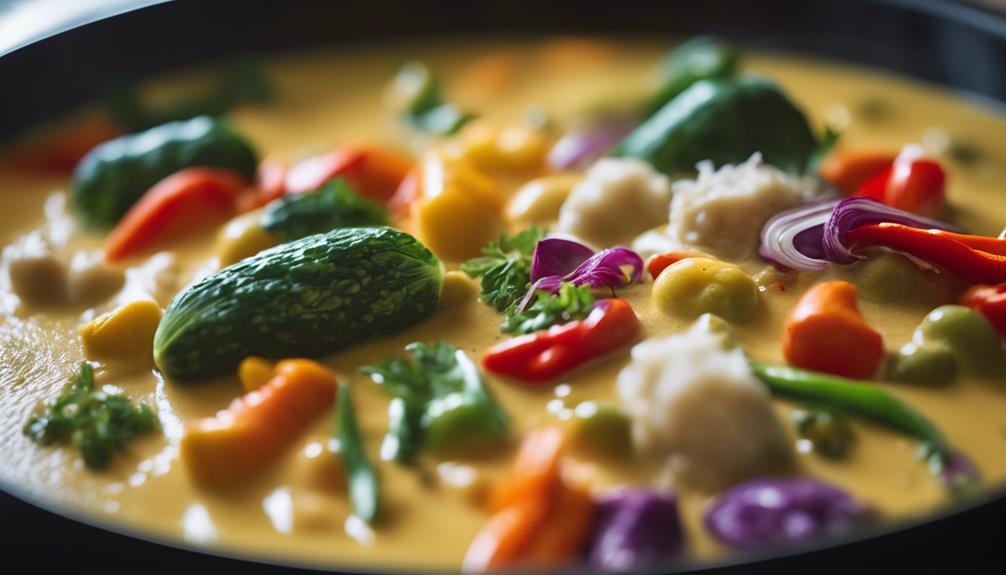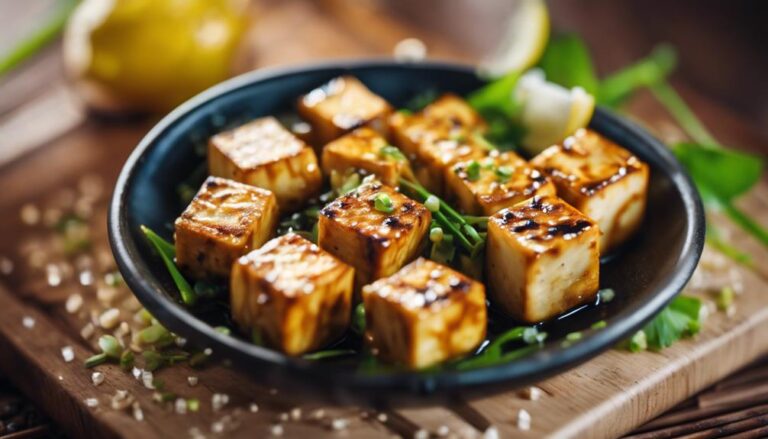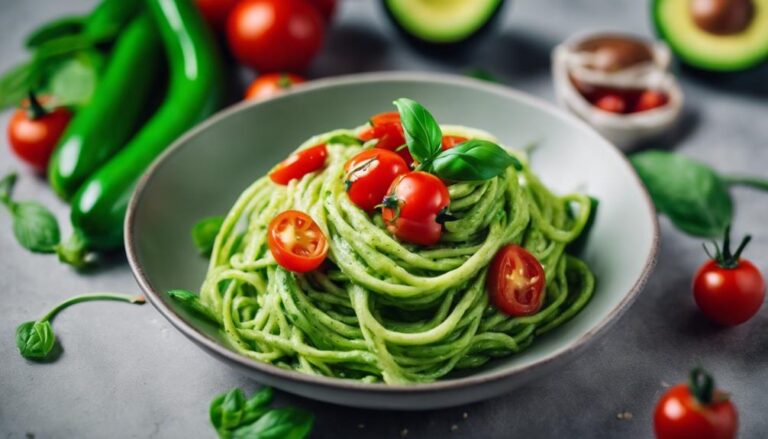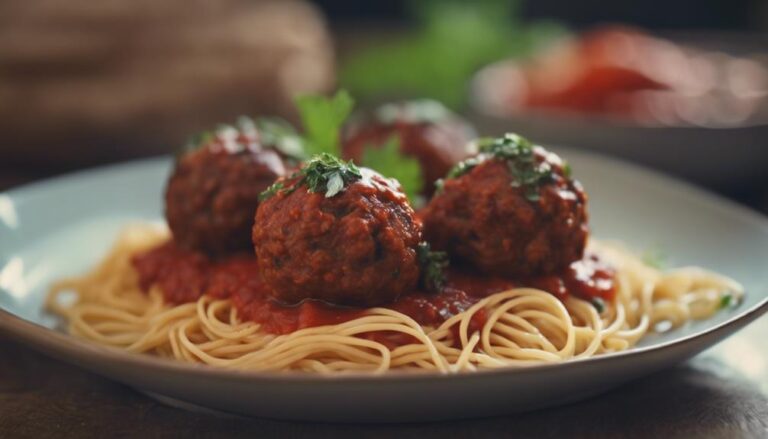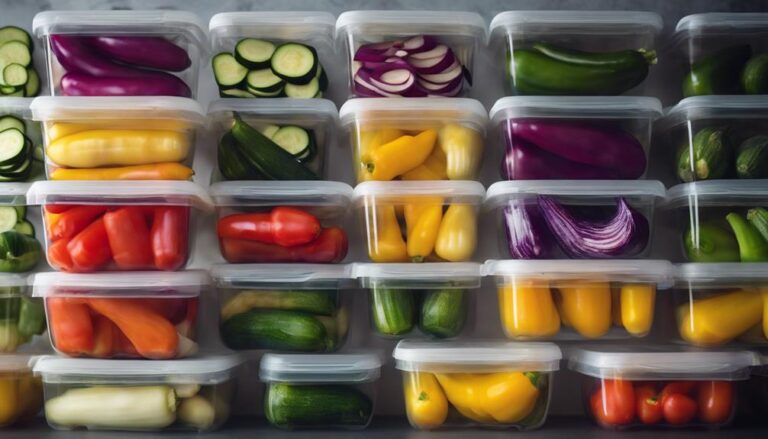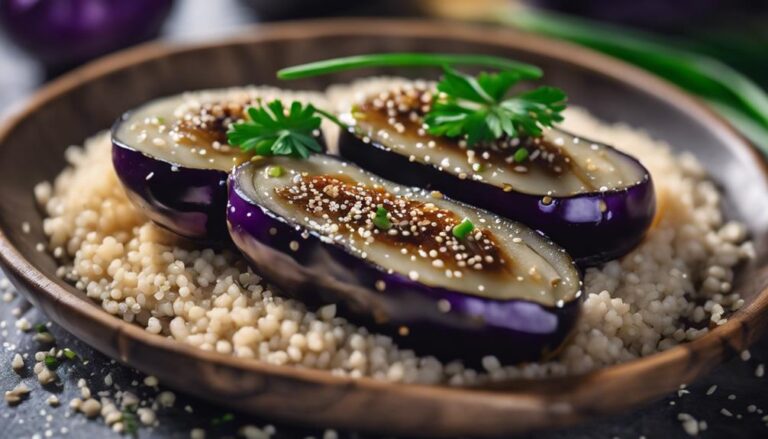Sous Vide Thai Vegetable Curry With Coconut Milk
Immerse yourself in the exotic blend of Thai flavors with succulent vegetables cooked sous vide style in creamy coconut milk for a velvety texture. Discover the tender bites of vegetables infused with the rich essence of traditional Thai curry paste, creating a symphony of taste that dances on your palate. Let the vibrant colors and aromatic herbs transport you to the heart of Thai culinary heritage, a journey that tantalizes your senses and elevates your dining experience. Unlock the full potential of this dish, and explore into a world of culinary delight waiting to be savored.
What You Will Learn Here
- Precise sous vide cooking retains flavors and nutrients.
- Dairy-free coconut milk adds richness and creaminess.
- Thai vegetables provide a variety of textures.
- Gluten-free, egg-free, and vegan-friendly dish.
- Caters to diverse dietary preferences without restrictions.
Curry's Evolution in Thailand
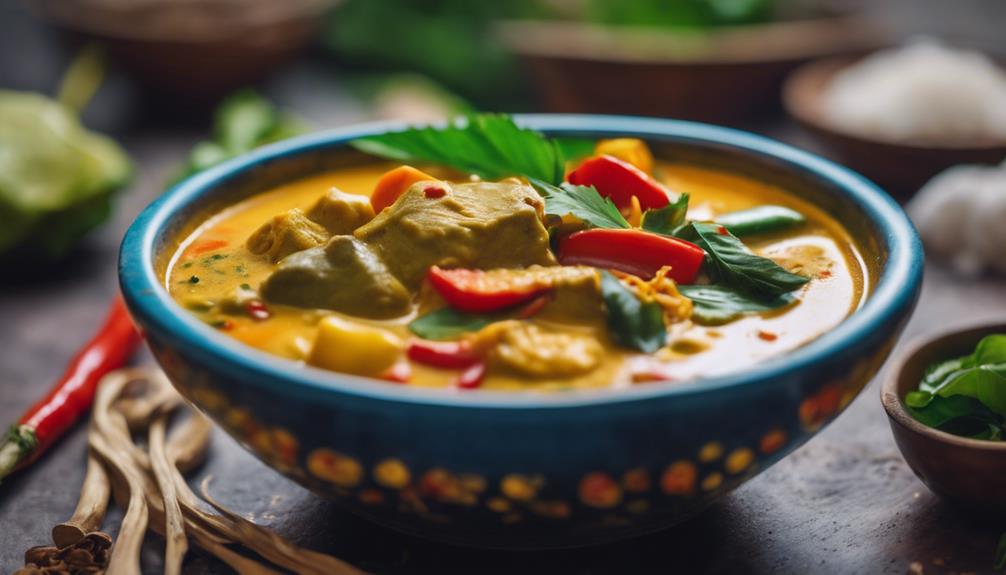
Thai curry has a rich history that reflects the country's diverse culinary influences.
The blend of fresh herbs, spices, and chilies in the curry paste creates a flavorful base for the dish.
Different regions in Thailand offer unique variations of curry, showcasing the country's diverse ingredients and regional flavors.
Curry in Thai History
With influences from Indian and Chinese culinary traditions, curry in Thailand has evolved over centuries, becoming a cornerstone of Thai cuisine. Thai curry pastes, traditionally prepared with a mortar and pestle, incorporate local ingredients like lemongrass, galangal, and kaffir lime, giving each curry its unique flavor profile.
The use of coconut milk in Thai curries is thought to have originated in the southern regions of Thailand, adding richness and creaminess to the dishes. Different regions within Thailand have developed their variations of curry, each with distinct flavors and spice levels, showcasing the diversity of culinary traditions across the country.
Curry holds a significant place in Thai culture, often being served during ceremonies and celebrations, reflecting its cultural importance and widespread popularity.
Ingredients and Flavors
Incorporating a diverse array of fresh vegetables and aromatic herbs, the evolution of vegetable curry in Thailand has been marked by a rich tapestry of flavors and ingredients. Thai vegetable curry traditionally combines a variety of fresh vegetables like eggplant, bell peppers, and bamboo shoots, creating a colorful and nutritious dish.
The creamy and rich base of coconut milk blends harmoniously with Thai curry paste, made from a blend of aromatic herbs and spices, to deliver a depth of flavor that's truly distinctive. The modern twist on Thai vegetable curry includes the use of plant-based proteins such as tofu and tempeh, offering a healthier and more sustainable option.
Adding fresh herbs like Thai basil, kaffir lime leaves, and cilantro elevates the authenticity and aroma of this sous vide Thai vegetable curry, making it a delightful culinary experience.
Regional Curry Variations
As regional influences intertwine with local culinary traditions, the reveal of curry in Thailand discloses a vibrant tapestry of diverse flavors and cooking techniques.
Southern Thai curry bursts with spice, thanks to fresh turmeric and an indulgence of coconut milk, creating a rich and fiery experience.
In contrast, the Northern Thai curry offers a milder palette, infused with the warmth of ginger, the tang of tamarind, and the crunch of peanuts.
Central Thai curry, particularly green and red varieties, enjoys international fame for its harmonious blend of flavors.
Each region's curry, shaped by unique ingredients and culinary practices, represents a cultural mosaic that showcases the richness and versatility of Thai cuisine.
Key Curry Ingredients
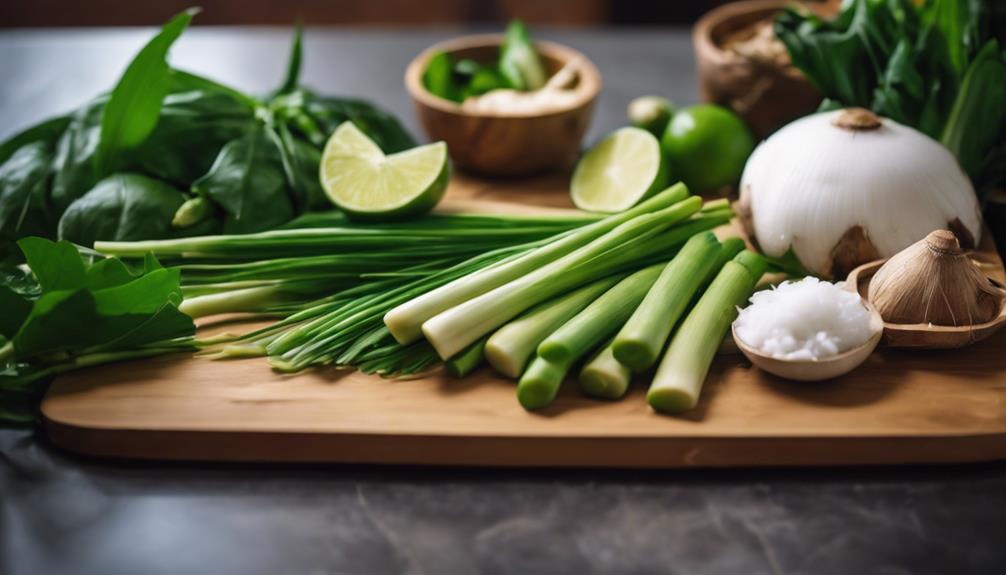
Coconut milk, with its rich and creamy texture, plays a pivotal role in enhancing the flavors of this Thai vegetable curry cooked sous vide style. Here are the key ingredients that make this dish a flavorful delight:
- Thai Curry Paste: The specific Thai curry paste used in this recipe is crucial for infusing the dish with authentic flavors that transport your taste buds to Thailand.
- Vegetables: A colorful array of Thai vegetables not only adds vibrancy to the curry but also guarantees a wholesome and nutritious meal that's bursting with freshness.
- Sous Vide Technique: The sous vide cooking method ensures that the vegetables are perfectly cooked, preserving their textures and flavors without being overcooked or losing their nutritional value.
- Dairy-Free Coconut Milk: For those with dietary restrictions or choosing a dairy-free lifestyle, coconut milk serves as a luxurious alternative, offering richness and creaminess without compromising on taste.
Sous Vide Beef Curry
When it comes to sous vide beef curry, the aspects to contemplate are:
- Sous Vide Beef With Lemongrass
- Beef Marinated in Aromatic Spices
- Beef Marinated in Thai Spices
These variations add depth and complexity to the dish, enhancing the overall flavor profile.
Experimenting with different beef marinades can elevate your sous vide beef curry to new levels of deliciousness.
Sous Vide Beef With Lemongrass
Lemongrass infuses the sous vide beef with an energizing citrusy scent, heightening the tenderness and flavor profile of this delectable curry dish. Here's why this sous vide beef with lemongrass is a must-try:
- Tender & Flavorful: The sous vide method guarantees a perfectly tender and flavorful beef experience.
- Citrusy & Aromatic: Lemongrass adds a revitalizing citrusy and aromatic dimension to the beef curry, elevating its taste.
- Precise Temperature Control: Sous vide cooking ensures exact temperature control, resulting in beef that's cooked to perfection every time.
- Succulent Outcome: By cooking the beef evenly and retaining its juices, this dish promises a succulent and mouthwatering curry that will leave you craving more.
Beef Marinated in Aromatic Spices
Infusing beef with a blend of aromatic spices before sous vide cooking enhances both the flavor and tenderness of this delectable curry dish. Here are some key points to keep in mind:
- Marinating beef in a mix of cumin, coriander, turmeric, and cinnamon adds layers of flavor.
- Sous vide cooking guarantees precise temperature control for perfectly cooked beef every time.
- Allowing the beef to marinate for at least 1-2 hours ensures the spices penetrate the meat, enhancing taste.
- The result of sous vide beef curry is juicy, flavorful, and tender meat that pairs perfectly with the Thai vegetable curry and coconut milk, creating a harmonious blend of flavors and textures.
Beef Marinated in Thai Spices
Marinating beef in a blend of traditional Thai spices infuses the meat with authentic flavors that will elevate your sous vide beef curry to a whole new level of deliciousness.
When you combine the tenderness of sous vide-cooked beef with the aromatic essence of Thai spices like lemongrass, galangal, and kaffir lime leaves, every bite becomes a flavor explosion.
The process of marinating the beef allows the spices to penetrate deep into the meat, ensuring each slice is packed with bold and exotic tastes.
As the beef cooks slowly in the sous vide, the flavors intensify, creating a mouthwatering curry that perfectly balances the richness of coconut milk with the fragrant notes of the spices.
Beef Marinating Techniques
When marinating beef for sous vide cooking, focus on the basics: time, technique, and seasoning.
Marinating beef for a few hours in the refrigerator allows the flavors to infuse deeply into the meat, enhancing the overall taste.
Opt for Thai curry blend seasoning to add a rich and aromatic dimension to your dish.
Beef Marinating Basics
To achieve perfectly tender and flavorful beef, mastering the art of marinating is essential. Marinating beef helps tenderize the meat by breaking down tough fibers, making it easier to chew.
Additionally, it enhances the flavor profile of the beef by allowing it to absorb various seasonings and spices, creating a more enjoyable eating experience.
Furthermore, marinating beef can also add moisture to the meat, preventing it from becoming dry during the cooking process.
Utilizing different marinating techniques, such as using acidic ingredients like vinegar or citrus juices, or enzymatic marinades containing ingredients like papaya or ginger, can further enhance the texture and taste of the beef.
The right marinating time, ranging from 30 minutes to overnight, is vital to ensure the flavors penetrate the beef effectively, resulting in a delicious dish packed with rich flavors.
Marinating Time Recommendations
For optimal results in marinating beef, consider the duration based on the specific cut and desired outcome, as it plays a vital role in enhancing both flavor and tenderness. When preparing beef for sous vide cooking, marinating times can vary from as little as 30 minutes to up to 24 hours.
Opting for a vacuum-sealed bag during marination can assist in infusing the meat with flavors effectively. Utilizing acidic ingredients such as vinegar or citrus juice in your marinade can aid in tenderizing the beef, resulting in a more succulent end product.
Adding a mix of herbs, spices, and aromatics to your marination process not only enhances the flavor but also contributes to the complexity of the dish when cooked sous vide. Remember, the marinating time is pivotal in achieving that perfect balance of tenderness and taste.
Recommended Seasonings for Marination
Consider incorporating a medley of soy sauce, garlic, ginger, and fragrant herbs to elevate the depth of flavor in your beef marination process. These seasonings not only add complexity but also complement the rich flavors found in Thai curry dishes. Additionally, acidic ingredients like vinegar or citrus juice can help tenderize the beef, making it more succulent and flavorful. Experiment with different combinations to find your perfect balance of flavors. Remember to let the beef marinate for at least 30 minutes to allow the seasonings to penetrate the meat fully. Below is a table showcasing some recommended seasonings for marinating beef:
| Seasoning | Flavor Profile | Purpose |
|---|---|---|
| Soy Sauce | Savory | Adds umami |
| Garlic | Pungent | Enhances taste |
| Ginger | Spicy | Adds warmth |
| Fragrant Herbs | Aromatic | Adds freshness |
Final Thoughts
As you contemplate the lively flavors and perfectly cooked vegetables in this sous vide Thai vegetable curry with coconut milk, it becomes clear that this dish truly embodies a harmonious blend of textures and tastes.
The precise temperature control provided by the sous vide cooking technique guarantees that each vegetable retains its natural flavors and nutrients, resulting in a delightful culinary experience.
The richness and creaminess from the coconut milk elevate the dish, creating a luxurious mouthfeel that complements the bold notes of the Thai curry paste.
The addition of eggplant, zucchini, and green beans not only adds a variety of textures but also enhances the nutritional value of the curry, making it a wholesome and satisfying meal.
Additionally, the fact that this dish is dairy-free, egg-free, gluten-free, and vegan caters to a wide range of dietary preferences, allowing everyone to indulge in its delicious flavors without any restrictions.
Frequently Asked Questions
What Does Coconut Milk Do to Curry?
Coconut milk in curry is like a culinary superhero. It adds flavor enhancement, creamy texture, richness addition, and balance to the spices. You'll love the creamy base it creates, enhancing the overall depth and creating a smooth, creamy finish.
Does Thai Curry Use Coconut Milk?
Yes, Thai curry uses coconut milk for its rich, creamy texture and flavor enhancement. The fats in coconut milk carry the spices and ingredients, creating the authentic taste of Thai cuisine. You can't beat coconut milk in traditional Thai curry recipes.
Do You Add Coconut Milk to Curry at the Beginning or End?
For a rich and creamy texture, you add coconut milk at the beginning of cooking curry. This infuses flavors and creates a well-balanced dish. However, adding coconut milk at the end can give a fresher taste to your curry.
Can You Replace Coconut Milk With Regular Milk in Thai Curry?
You can substitute regular milk for coconut milk in Thai curry, but the flavor profile and creamy texture will differ. Experiment with dairy substitutes to discover unique tastes. Consider dietary restrictions, vegan options, and culinary traditions for recipe variations.
Conclusion
Overall, this sous vide Thai vegetable curry with coconut milk is a flavorful and aromatic dish that highlights the vibrant and diverse flavors of Thai cuisine.
The combination of fresh vegetables, rich coconut milk, and traditional curry spices creates a harmonious balance of sweet, spicy, and savory notes.
By utilizing the sous vide cooking method, the vegetables are perfectly cooked and infused with the delicious curry flavors, making this dish a must-try for any curry lover.
